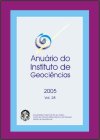Identification of cianobacterica in sediments of the Pitanguinha Lagoon, Rio de Janeiro, Brazil
DOI:
https://doi.org/10.11137/2005_1_92-100Abstract
The Pitanguinha lagoon is a hypersaline lagoon. It is located between the latitudes 22º55'42"-22º56'00"S and longitudes 42º20'45"- 42º21'30"W, in the Rio de Janeiro State. The air temperatura in average varies from 19º to 31º and presents an annual pluviometric rate of 900mm, with an evaporation of 1.400mm. The psammic cyanobacteria lives in surface sediment among sedimentary grains mainly quartz. The objective of this study was the identification of psammic cyanobacteria finding in the marginal portion the Pitanguinha Lagoon. Collections were done during 2003-2004, in the tide period the lagoon, where five collection stations was established. The taxonomic analisys was made with fresh and permanent slides, through optic microscope mensuration, that evalued its classic morphologic characteristics. The families Chroococcaceae Nägeli 1849 and Synechococcaceae Komárek & Anagnostidis 1995 were the most frequent with 35 % of the species. The others families presented the following percents: Phormidiaceae Anagnostidis & Komárek 1988 - 10%; Nostocaceae Bourrelly 1970 - 5%; Pseudanabaenaceae Anagnostidis & Komárek 1988 - 5%; Schizothricaceae Elenkin 1934 - 5% e Xenococcaceae Ercergovi - 5%.Downloads
Download data is not yet available.
Downloads
Published
2005-06-01
How to Cite
Silva e Silva, L. H., Damazio, C. M. and Iespa, A. A. C. (2005) “Identification of cianobacterica in sediments of the Pitanguinha Lagoon, Rio de Janeiro, Brazil”, Anuário do Instituto de Geociências. Rio de Janeiro, BR, 28(1), pp. 92–100. doi: 10.11137/2005_1_92-100.
Issue
Section
Article
License
This journal is licensed under a Creative Commons — Attribution 4.0 International — CC BY 4.0, which permits use, distribution and reproduction in any medium, provided the original work is properly cited.















